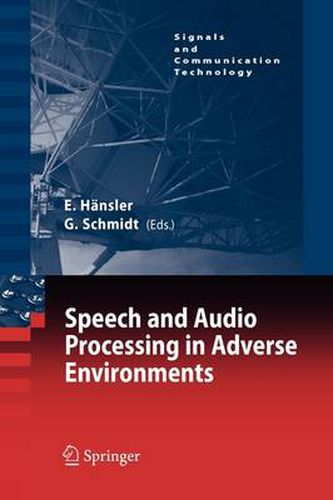Readings Newsletter
Become a Readings Member to make your shopping experience even easier.
Sign in or sign up for free!
You’re not far away from qualifying for FREE standard shipping within Australia
You’ve qualified for FREE standard shipping within Australia
The cart is loading…






This title is printed to order. This book may have been self-published. If so, we cannot guarantee the quality of the content. In the main most books will have gone through the editing process however some may not. We therefore suggest that you be aware of this before ordering this book. If in doubt check either the author or publisher’s details as we are unable to accept any returns unless they are faulty. Please contact us if you have any questions.
Users of signal processing systems are never satis?ed with the system they currently use. They are constantly asking for higher quality, faster perf- mance, more comfort and lower prices. Researchers and developers should be appreciative for this attitude. It justi?es their constant e?ort for improved systems. Better knowledge about biological and physical interrelations c- ing along with more powerful technologies are their engines on the endless road to perfect systems. This book is an impressive image of this process. After Acoustic Echo 1 and Noise Control published in 2004 many new results lead to Topics in 2 Acoustic Echo and Noise Control edited in 2006 . Today - in 2008 - even morenew?ndingsandsystemscouldbecollectedinthisbook.Comparingthe contributions in both edited volumes progress in knowledge and technology becomesclearlyvisible:Blindmethodsandmultiinputsystemsreplace h- ble low complexity systems. The functionality of new systems is less and less limited by the processing power available under economic constraints. The editors have to thank all the authors for their contributions. They cooperated readily in our e?ort to unify the layout of the chapters, the ter- nology, and the symbols used. It was a pleasure to work with all of them. Furthermore, it is the editors concern to thank Christoph Baumann and the Springer Publishing Company for the encouragement and help in publi- ing this book.
$9.00 standard shipping within Australia
FREE standard shipping within Australia for orders over $100.00
Express & International shipping calculated at checkout
This title is printed to order. This book may have been self-published. If so, we cannot guarantee the quality of the content. In the main most books will have gone through the editing process however some may not. We therefore suggest that you be aware of this before ordering this book. If in doubt check either the author or publisher’s details as we are unable to accept any returns unless they are faulty. Please contact us if you have any questions.
Users of signal processing systems are never satis?ed with the system they currently use. They are constantly asking for higher quality, faster perf- mance, more comfort and lower prices. Researchers and developers should be appreciative for this attitude. It justi?es their constant e?ort for improved systems. Better knowledge about biological and physical interrelations c- ing along with more powerful technologies are their engines on the endless road to perfect systems. This book is an impressive image of this process. After Acoustic Echo 1 and Noise Control published in 2004 many new results lead to Topics in 2 Acoustic Echo and Noise Control edited in 2006 . Today - in 2008 - even morenew?ndingsandsystemscouldbecollectedinthisbook.Comparingthe contributions in both edited volumes progress in knowledge and technology becomesclearlyvisible:Blindmethodsandmultiinputsystemsreplace h- ble low complexity systems. The functionality of new systems is less and less limited by the processing power available under economic constraints. The editors have to thank all the authors for their contributions. They cooperated readily in our e?ort to unify the layout of the chapters, the ter- nology, and the symbols used. It was a pleasure to work with all of them. Furthermore, it is the editors concern to thank Christoph Baumann and the Springer Publishing Company for the encouragement and help in publi- ing this book.